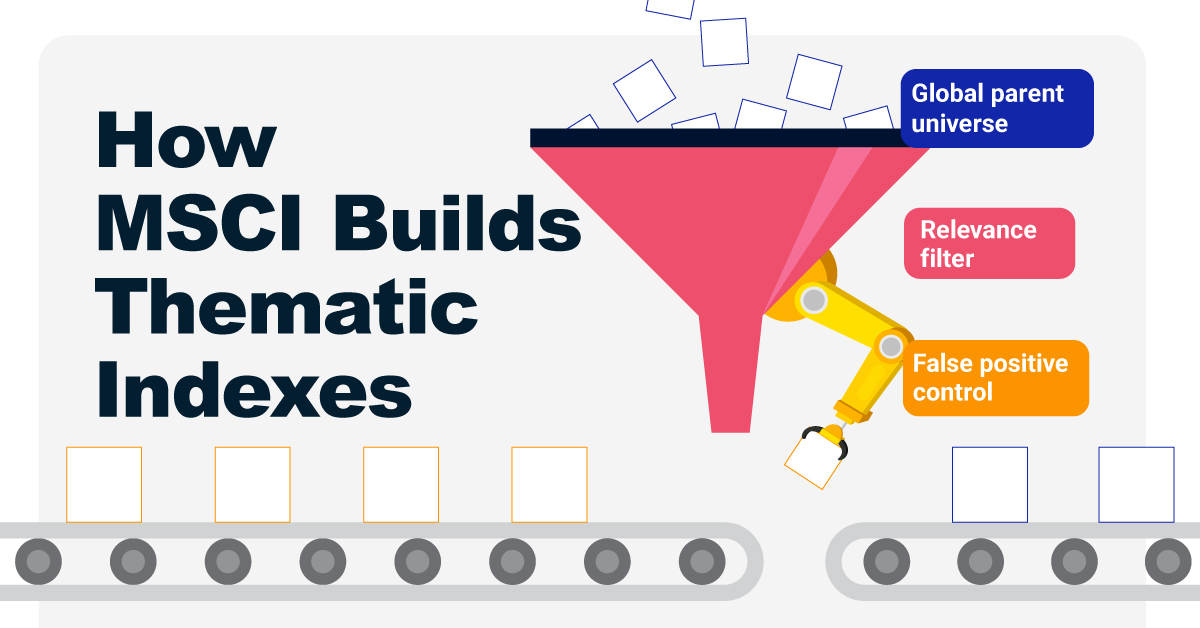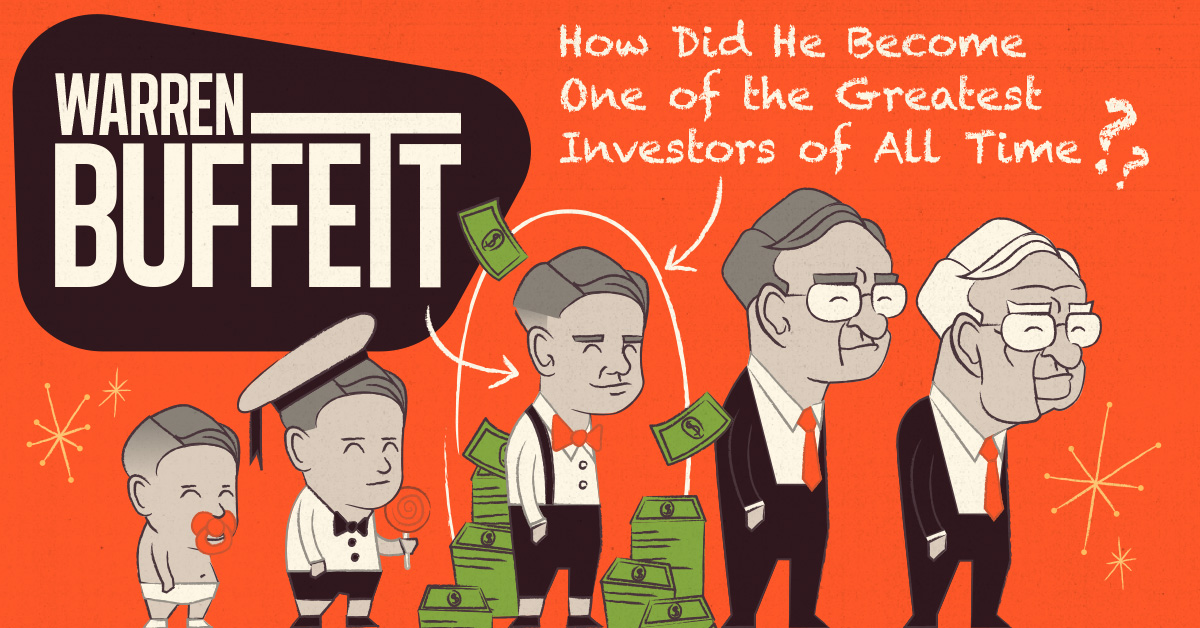Investor Education
The Remarkable Early Years of Warren Buffett
For most people, the “Oracle of Omaha” needs no introduction. With a self-made net worth of $84 billion, some experts consider the 87-year-old to be the greatest investor of all-time.
Despite his incredible achievements and decades in the public eye, the modest Midwesterner is frugal, relatable, and full of humility – and his life story is an endless source of lessons to aspiring business professionals around the world.
The Warren Buffett Series
Part 1: The Early Years
Today’s infographic, which is done in partnership with finder.com, is Part 1 of the Warren Buffett Series, a five-part biographical series about the legendary investor.

Note: Stay tuned for future parts with our free mailing list.
The young Warren Buffett was clearly a special kid. He ran his first “business” when he was five years old, and he invested in his first stock when he was 11. Buffett even managed to emerge from high school richer than his teachers.
But what lessons can we learn from Buffett’s prolific childhood – and how did his experiences as a young man shape him into the magnate we know today?
From Numbers to Dollar Signs
Even for someone as gifted and focused as Buffett, a serendipitous insight played a crucial role in charting his future course.
During a visit to the New York Stock Exchange when he was 10 years old, the sight of a young man rolling custom, handmade cigars on the floor made an outsized impact on him. In particular, Buffett realized that such a job couldn’t exist without massive amounts of money flowing through the stock market.
This unexpected epiphany planted the seed for stocks in his brain, and Warren’s long fascination with numbers soon shifted towards dollars.
The Buffett Growth Mindset
Warren Buffett famously spends 80% of his day reading – and the written word was just as important to his younger self. As a lad, one book that caught Buffett’s eye was One Thousand Ways to Make $1,000 by F.C. Minaker
Specifically, the book showed Buffett how $1,000 could compound over time – and that the earlier you had money working for you, the better.
An important lesson from the book? There’s a massive difference in returns between 60 and 70 year compound interest scenarios. In other words, annualized returns are just one part of the equation – but how long the money compounds is the other crucial part. This is a big part of the reason why Warren Buffett got started early.
Warren Buffett’s First Stock
Through his various activities, Buffett had $120 saved by age 11. Naturally, he invested it in a stock, co-investing his sister’s money. They each bought three shares of Cities Service Preferred for $38.25 each.
The share price promptly dropped to $27, but Buffett waited it out. When it got to $40, he sold to net a small profit – however, the stock soon after went all the way to $202!
Warren calls this one of the most important moments in his life, and he learned three lessons:
- Don’t overly fixate on what he paid for the stock
- Don’t rush unthinkingly to grab a small profit. He could have made $492 if he was more patient
- He didn’t want to have responsibility for anyone else’s money unless he was sure he could succeed
These important lessons would eventually tie in well to his value investing philosophy.
Odd Jobs
The young Buffett wasn’t afraid to try new things to build up his capital. He collected golf balls, sold peanuts and popcorn, sold gum and Coca-Cola, and even created tipsheets for horse races on a typewriter.
Some of his stranger endeavors? He launched Buffett’s Approval Service and sold stamps to collectors around the country, and he also launched Buffett’s Showroom Shine – a car shining business that didn’t last too long.
Warren’s Work Ethic
By the end of high school, Buffett had launched multiple businesses, sold thousands of golf balls, read at least 100 books on business, and hawked 600,000 newspapers.
This hard work led to him having a fortune of $5,000 by high school graduation time, the equivalent of $55,000 in today’s currency. He even owned land at this point, after buying 40 acres of Nebraska farmland with his newspaper profits.
Knocked Off Course
After high school, Buffett decided he was a shoe-in for Harvard. He knew it would be stimulating for him intellectually, and that the famed business school would allow him to develop a strong network.
The only problem? He got rejected.
Instead of letting this get to him, he discovered Benjamin Graham’s book The Intelligent Investor and fell in love. It was the methodical investing framework he needed, and he would later call it the “best book about investing ever written”.
Buffett would soon be accepted at Columbia Business School, where Benjamin Graham and David Dodd taught finance. Graham became Buffett’s idol, and his second-biggest influence behind his own father.
Other Notes
Part 2 of the Warren Buffett Series will be released in early January 2018.
Credits: This infographic would not be possible without the great biographies done by Roger Lowenstein (Buffett: The Making of an American Capitalist) and Alice Schroeder (The Snowball), as well as numerous other sources cataloging Buffett’s life online.
Investor Education
How MSCI Builds Thematic Indexes: A Step-by-Step Guide
From developing an index objective to choosing relevant stocks, this graphic breaks down how MSCI builds thematic indexes using examples.

How MSCI Builds Thematic Indexes: A Step-by-Step Guide
Have you ever wondered how MSCI builds its thematic indexes?
To capture long-term, structural trends that could drive business performance in the future, the company follows a systematic approach. This graphic from MSCI breaks down each step in the process used to create its thematic indexes.
Step 1: Develop an Index Objective
MSCI first builds a broad statement of what the theme aims to capture based on extensive research and insights from industry experts.
Steps 2 and 3: List Sub-Themes, Generate Keyword List
Together with experts, MSCI creates a list of sub-themes or “seedwords” to identify aligned business activities.
The team then assembles a collection of suitable documents describing the theme. Natural language processing efficiently analyzes word frequency and relevance to generate a more detailed set of keywords contextually similar to the seedwords.
Step 4: Find Relevant Companies
By analyzing financial reports, MSCI picks companies relevant to the theme using two methods:
- Direct approach: Revenue from a company’s business segment is considered 100% relevant if the segment name matches a theme keyword. Standard Industrial Classification (SIC) codes from these directly-matched segments make up the eligible SIC code list used in the indirect approach.
- Indirect approach: If a segment name doesn’t match theme keywords, MSCI will:
- Analyze the density of theme keywords mentioned in the company’s description. A minimum of two unique keywords is required.
- The keyword density determines a “discount factor” to reflect lower certainty in theme alignment.
- Revenue from business segments with an eligible SIC code, regardless of how they are named, is scaled down by the discount factor.
The total percentage of revenue applicable to the theme from both approaches determines a company’s relevance score.
Step 5: Select the Stocks
Finally, MSCI narrows down the stocks that will be included:
- Global parent universe: The ACWI Investable Market Index (IMI) is the starting point for standard thematic indexes.
- Relevance filter: The universe is filtered for companies with a relevance score of at least 25%.
- False positive control: Eligible companies that are mapped to un-related GICS sub-industries are removed.
Companies with higher relevance scores and market caps have a higher weighting in the index, with the maximum weighting for any one issuer capped at 5%. The final selected stocks span various sectors.
MSCI Thematic Indexes: Regularly Updated and Rules-Based
Once an index is built, it is reviewed semi-annually and updated based on:
- Changes to the parent index
- Changes at individual companies
- Theme developments based on expert input
Theme keywords are reviewed yearly in May. Overall, MSCI’s thematic index construction process is objective, scalable, and flexible. The process can be customized based on the theme(s) you want to capture.

Learn more about MSCI’s thematic indexes.

-

 Investor Education6 months ago
Investor Education6 months agoThe 20 Most Common Investing Mistakes, in One Chart
Here are the most common investing mistakes to avoid, from emotionally-driven investing to paying too much in fees.
-

 Stocks10 months ago
Stocks10 months agoVisualizing BlackRock’s Top Equity Holdings
BlackRock is the world’s largest asset manager, with over $9 trillion in holdings. Here are the company’s top equity holdings.
-

 Investor Education11 months ago
Investor Education11 months ago10-Year Annualized Forecasts for Major Asset Classes
This infographic visualizes 10-year annualized forecasts for both equities and fixed income using data from Vanguard.
-

 Investor Education1 year ago
Investor Education1 year agoVisualizing 90 Years of Stock and Bond Portfolio Performance
How have investment returns for different portfolio allocations of stocks and bonds compared over the last 90 years?
-

 Debt2 years ago
Debt2 years agoCountries with the Highest Default Risk in 2022
In this infographic, we examine new data that ranks the top 25 countries by their default risk.
-

 Markets2 years ago
Markets2 years agoThe Best Months for Stock Market Gains
This infographic analyzes over 30 years of stock market performance to identify the best and worst months for gains.
-

 Markets1 week ago
Markets1 week agoU.S. Debt Interest Payments Reach $1 Trillion
-

 Markets2 weeks ago
Markets2 weeks agoRanked: The Most Valuable Housing Markets in America
-

 Money2 weeks ago
Money2 weeks agoWhich States Have the Highest Minimum Wage in America?
-

 AI2 weeks ago
AI2 weeks agoRanked: Semiconductor Companies by Industry Revenue Share
-

 Markets2 weeks ago
Markets2 weeks agoRanked: The World’s Top Flight Routes, by Revenue
-

 Countries2 weeks ago
Countries2 weeks agoPopulation Projections: The World’s 6 Largest Countries in 2075
-

 Markets2 weeks ago
Markets2 weeks agoThe Top 10 States by Real GDP Growth in 2023
-

 Money2 weeks ago
Money2 weeks agoThe Smallest Gender Wage Gaps in OECD Countries





















